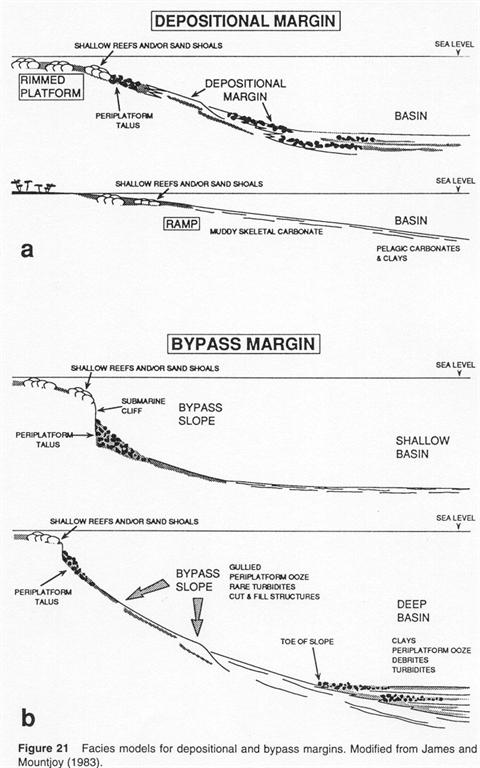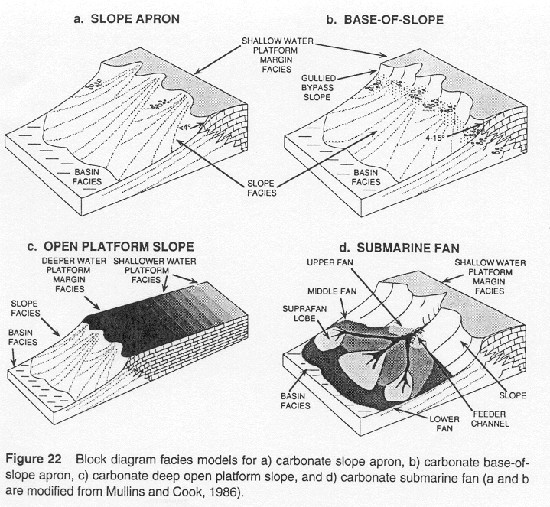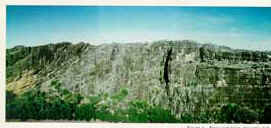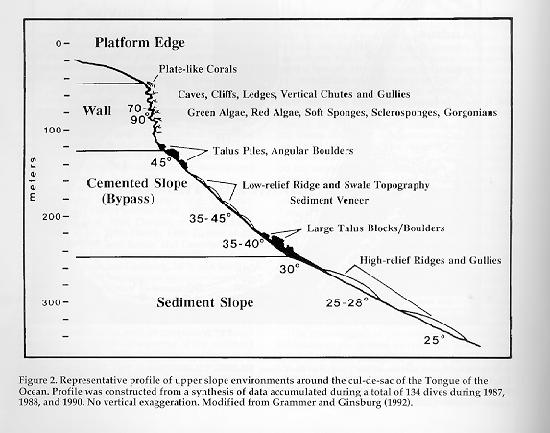Slope Type and Morphology
The classification of carbonate slopes is based primarily on the geometry of the slope deposits and the adjacent platform margin.carbonate aprons are wedge-shaped bodies that thicken towards the platform margin, and in which facies belts parallel the margin.Based upon this classification scheme, three types of geometries are recognized:Rimmed platform slope apron: The carbonate apron in this model extends continuously from the basin along a gentle gradient (<4°) to a shallow water platform margin.The sediment deposited on this type of slope is predominately turbidites and debris sheets interbedded with suspension deposits.This slope type is best observed in ancient sequences, since most modern carbonate slopes form beneath steep forereef escarpments.Rimmed platform base-of-slope apron: This type of slope forms down-slope from the platform/slope break along a steep gradient (>4°).Sediment transport occurs through a series of closely spaced gullies, which transport shallow water, and slope derived sediment through some portion of the upper to the middle slope.This is also known as a bypass margin.The sediment emerging from these gullies creates a series of small, interleaved fan-shaped deposits, forming platform-margin parallel facies belts.At the top of the apron course debrite and tallus are common, especially if a steep escarpment is present.This slope type is also well preserved in ancient examples.Open (unrimmed) platform apron: This type of slope develops in areas where the platform/slope margin is below depths of the carbonate factory.In this case the sediment is likely to be dominantly pelagic in origin.Also mass-wasting deposits including turbidites and debrites originating from platform margin are common. This type of slope is especially difficult to identify in the rock record because it is difficult to distinguish from rimmed shallow water platforms.Submarine Fans of carbonate: These slope deposits are believed to be built from a point source, fed by a major submarine channel.The fan consists of debris flow conglomerates and coarse turbidites.The sediment is dispersed in a radial fashion.The following diagrams illustrate the different slope types outlined

(after Coniglio and Dix, 1992).

(Coniglio and Dix, 1992)

(Scholle et al., 1983)

(Brown and Loucks, 1993)
Comparison table for carbonate slope
| Slope |
Sedimentation Rates |
pelagic sediments |
Rock Falls |
Slides / Slumps |
Debris /Grain Flows |
Turbidity flows and deposits |
Bottom Current Deposits |
| Ancient |
Estimated lower carbonate accumulation and sedimentation rate |
Undisturbed slope sediments typically dark gray to black limestones, calcsiliclastics,& wackstones |
In absence of "good" stratigraphic relationships to a steep slope are difficult to identify |
Submarine slide deposits are common and range in thickness from sever centimeter to meters |
Preserved in ancient deposits and common throughout the geologic time |
Common throughout geologic time recognizable, by fining upward gravity flow sequences |
In the absence of good paleo -current data the association of facies is difficult |
| Modern |
High carbonate accumulation and sedimentation rates in Holocene to present |
Fine-grained undisturbed carbonate ooze, thinning with depth |
Steep escarpments highly unstable, basal scarp deposits, wide clast range |
In the Bahamas modern carbonate slope systems slides are infrequent but are analogous to ancient slides and slumps |
Common and similar to ancient analogue: massive, poorly sorted, mud-supported or grain-supported debris |
Represent lower slope carbonate facies-fining upward gravity flow similar to ancient analogue |
Much like the ancient analogue, open seaways of the Bahamas allows for strong bottom current responsible for winnowing and redistributing carbonates |
References and Sources: Bates, R.L., Jackson, J.A. Dictionary of Geological Terms. Anchor Books, New York : 1984.Brown, A.A., Loucks, R.G. Influence of Sediment Type and Depositional Processes on stratal Patterns in the Permian basin-Margin Lamar limestone, McKittrick Canyon, Texas in carbonate :Recent Developments and Applications. Ed. Loucks, R.G. and Sarg, J.F. AAPG Memoir 57, Tulsa: 1993. p.145.
Coniglio, M., Dix, G.R. carbonate Slopes in Facies Models: Response to Sea Level Change. Ed. R.G. Walker and N. P. James. Geological Association of Canada, St.Johns: 1992. pp 349-373.Scholle, P.A., Bebout, D.G., Moore, C.H., (Eds.). carbonate Depositional Environments. AAPG Memoir 33, Tulsa: 1983.